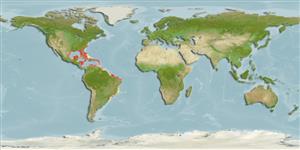Common names from other countries
Environment: milieu / climate zone / depth range / distribution range
Ecologia
; intervalo de profundidade 4 - 100 m (Ref. 108813). Tropical
Western Atlantic.
Length at first maturity / Tamanho / Peso / Idade
Maturity: Lm ? range ? - ? cm
Shape varies as globular, almost spherical, or erect egg-shaped; apex usually flattened or depressed. Common width is between 15 to 20 cm. Surface scarred with numerous round cup-like depressions, i.e., porocalices, concentrating in the apical depression. Radiated spicules, protruding tips make remaining surface bristly. External color: orange, yellow-orange, or brownish orange. May be brown due to presence of algae or cyanobacteria. Rich yellow internally. Consistency elastic but firm. Few oscules.
Occurs in medium-energy reef environments and deep hard bottoms (Ref. 85482).
Life cycle and mating behavior
Maturidade | Reprodução | Desova | Ovos | Fecundidade | Larvas
Members of the class Demospongiae are hermaphroditic. Life cycle: The zygote develops into parenchymella larva (free-swimming) before settling down on a substrate where it grows into a young sponge.
Zea, S., T.P. Henkel and J.R. Pawlik. 2009. (Ref. 81728)
Status na Lista Vermelha da IUCN (Ref. 130435)
Status no CITES (Ref. 108899)
Not Evaluated
Not Evaluated
Uso pelos humanos
| FishSource |
Ferramentas
Mais informação
Idade/TamanhoCrescimentoComprimento-pesoComprimento-comprimentoMorfologiaLarvasAbundância
Fontes da internet
Estimates based on models
Preferred temperature
(Ref.
115969): 22.8 - 27.8, mean 25.7 (based on 340 cells).
Categoria de preço
Unknown.
